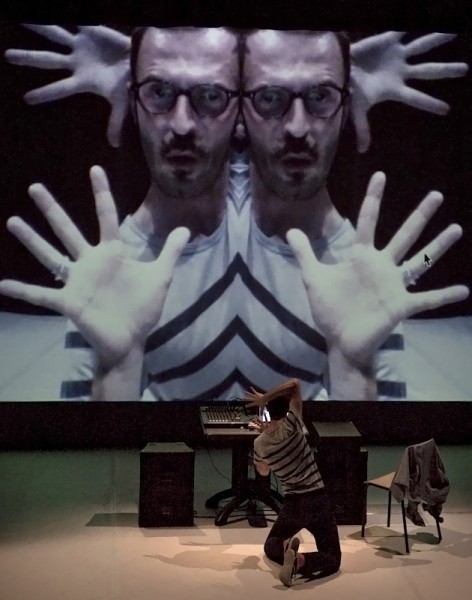The current Currency mini-season at The Place aims to facilitate a dialogue between dance artists from across Europe, in London. The three evenings each consist of a pre-show sharing of brief work-in-progress (a collaboration between an associate Work-Place artist and a European practitioner, thrown together in a blind studio date), then double-bill of new and exciting work from across the continent. Oh, and dinner! At each evening, you are treated to a communal dinner in the café, where you can break bread, have a chat and share your thoughts before the main event. The entire evening felt very relaxed and familial, with Eddie Nixon and his team joining in the fun and conversation too.
I’ll spare you my review of the café – although my veggie burrito was tasty and satisfying on a chilly evening after a hurried commute through the post-work throng – and move swiftly on the dancing. Igor Urzelai and Chiara Frigo’s pre-show sharing in the airy Founder’s Studio certainly promoted the concept of danced ideas realised and shared. The pair performed a series of gently unfolding arm gestures and focal shifts whilst in close contact. Their movements accelerated and decelerated in waves of repetitions. Midway through, they broke into a conversation, interrogating ideas of age, change and death (or, perhaps disintegration), addressing each topic with a lightness of touch that was both endearing and appealing. An interesting collaboration to keep an eye out for in the future, should they explore this seed further.
Settling in to the Robin Howard Theatre, I was unsure of what to expect. Alessandro Sciarroni’s Joseph posed the promise of ‘generating mysterious images like white rabbits from a magician’s hat’, and I couldn’t wait to see how the performer and choreographer was going to deliver! My skepticism was soon kicked to touch, as Sciarroni not only presented indiosyncratic and humorous movement material, but played both puppet and master by controlling the soundscape and imagery projected onto the cyclorama from his laptop, which was set centre stage. Setting up the theatrical device of using the computer’s camera to capture and project the front of his movement, the audience was able to take in three Sciarroni’s – his back, live on stage, his front, projected large, and him in miniature on the computer screen. Well-chosen and timed musical shifts enhanced the increasingly bizarre projected versions – facilitated by some funky Photobooth effects – and led to a break in the action, and a shift towards the interactive with the opening of networking site Chat Roulette. I don’t want to give away the ending, but Sciarroni manages to engineer a scenario where both virtual (or should that be remote?) participants and audience become as much part of the performance as the performer himself. I would thoroughly recommend seeing Joseph if you have a chance – often comical, at times contemplative, and concluding with an earnest dance in a Batman costume to an Antony and the Johnsons track, this piece was (literally) as engaging as it was entertaining.
Mor Shani positions his piece Flatland as a mockumentary based on a TED lecture presented by a neuroscientist who becomes, after a stroke, a subject in her own field of study. An actor – who delivers a version of the original lecture verbatim – is joined by a trio of dancers who may or may not react and/or represent in movement what the actor presents in speech. The piece, for me, was altogether simultaneously too transparent and too opaque. I found the actor’s delivery condescending and trite (perhaps this was where the ‘mockumentary’ aspect came in?), and whilst the speech was over-elucidatory of the conceptual starting point of the piece, the relationship between the actor, his words and the dancer’s movement seemed to have no connection whatsoever. The narrative arc of the dialogue suggested a lack of physical control, but a widening of mental horizons, whilst the movement was very restricted in both vocabulary and feeling. An interesting concept, but the use of the actual lecture prose in the performance felt superficial, and pairing this with the movement was at best an odd juxtaposition. This, in conjunction with what I felt was unnecessary and un-precipitated nudity and violence, left me longing for the whimsy that the programme note seemed to promise.
